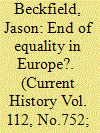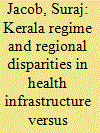| Srl | Item |
| 1 |
ID:
160543


|
|
|
|
|
| Summary/Abstract |
Social protection policies involve distributional politics and practices that pose significant challenges. Focusing on Indonesia, where such policies are rapidly expanding, this paper discusses two programmes most relevant to the poor—the rice for welfare (Rastra) scheme and the conditional cash transfer (PKH) programme. We elaborate on the tensions between a “layered” approach to social protection (where new institutional arrangements are placed on top of, or alongside existing ones) and a “nested” approach (where community-level distribution principles are located within wider state arrangements). The paper concludes that Indonesia is still looking for a welfare regime that is compatible with its political-economic situation and cultural practices. This study argues that, to improve the “fit” of social protection policies, policymakers will need to take a more polycentric approach, allowing the state-supported targeting logic to accommodate the social ethics and moral concerns of the country’s rural poor.
|
|
|
|
|
|
|
|
|
|
|
|
|
|
|
|
| 2 |
ID:
118281


|
|
|
|
|
| Publication |
2013.
|
| Summary/Abstract |
"[T]he level of income inequality within European nations has been increasing since neoliberalism took hold in the EU in the 1980s and 1990s.
|
|
|
|
|
|
|
|
|
|
|
|
|
|
|
|
| 3 |
ID:
130007


|
|
|
|
|
| Publication |
2014.
|
| Summary/Abstract |
Conventional wisdom holds that although at the time of Kerala state formation in 1956 the northern region (Malabar) lagged behind the southern region (Travancore-Cochin) in development indicators, inter-regional disparities reduced considerably in ensuing decades. The reduction in regional disparities is typically attributed to modern Kerala's welfare policy regime, which emphasized greater growth of infrastructure facilities in Malabar. This study presents evidence for health that suggests that while disparities in outcomes reduced over time, disparities in key infrastructural inputs did not reduce. These differing trends for infrastructure and outcomes are consistentwith a diminishing returns argument that may have little to do directly with the Kerala regime. Rather, the potency of the Kerala regime lays in its ability to increase development inputs throughout the state (albeit without favoring the lagging region) and consolidate the conditions for "public action" to effectively demand and utilize these inputs.
|
|
|
|
|
|
|
|
|
|
|
|
|
|
|
|